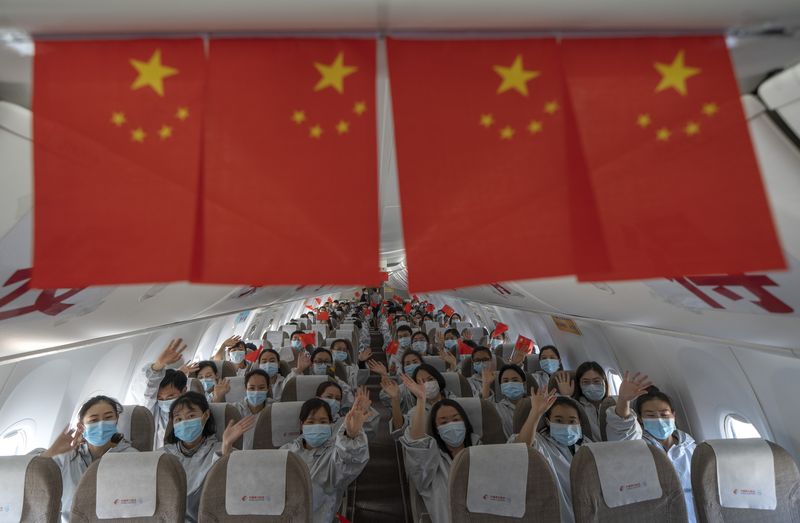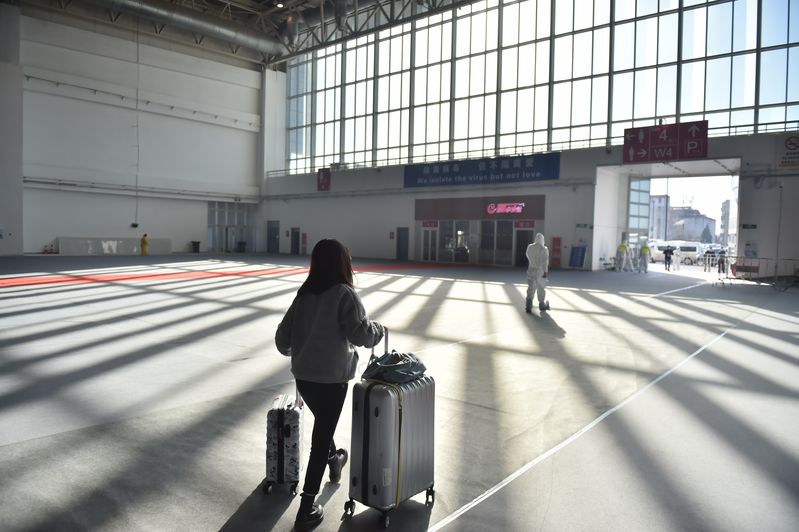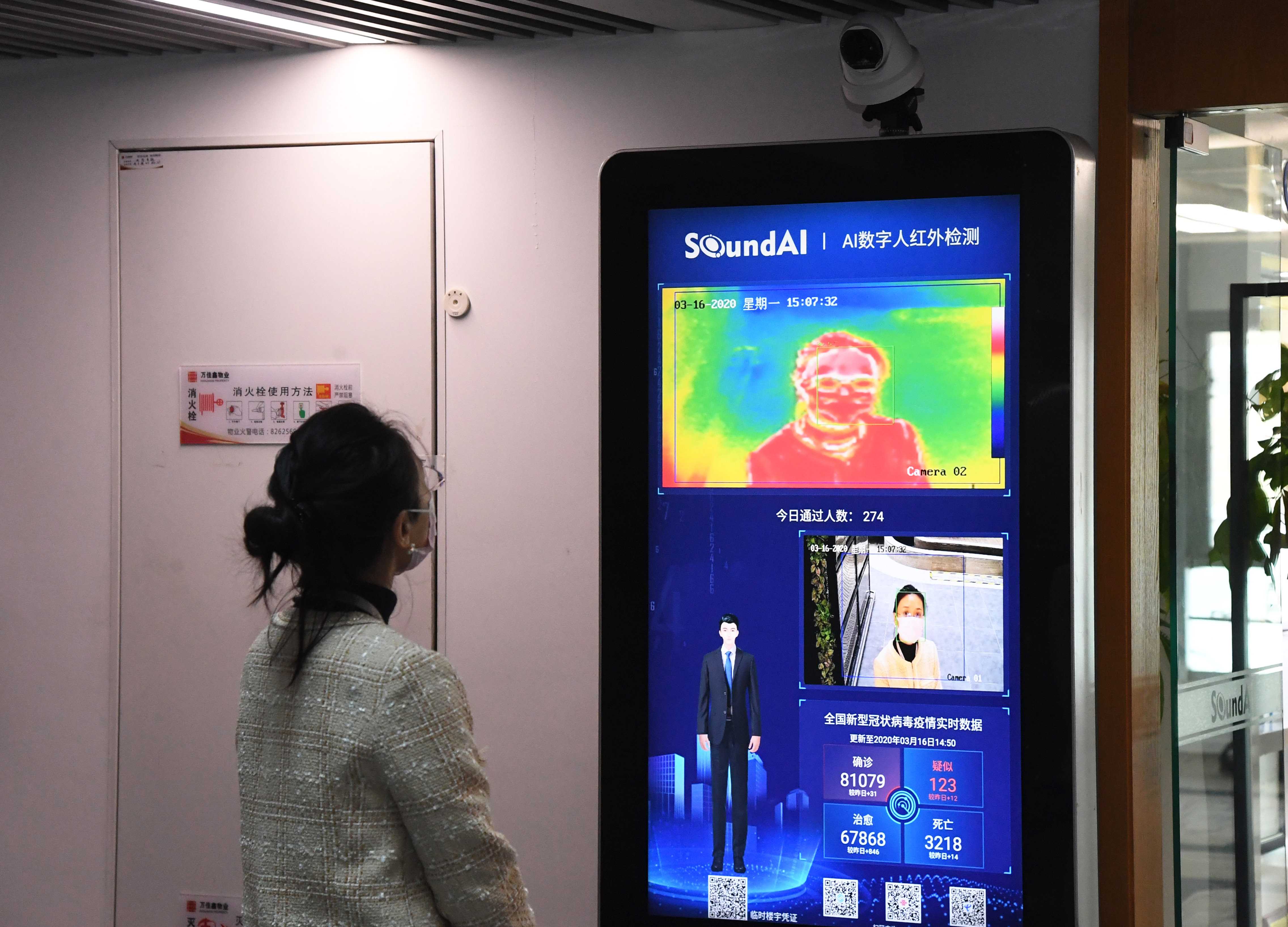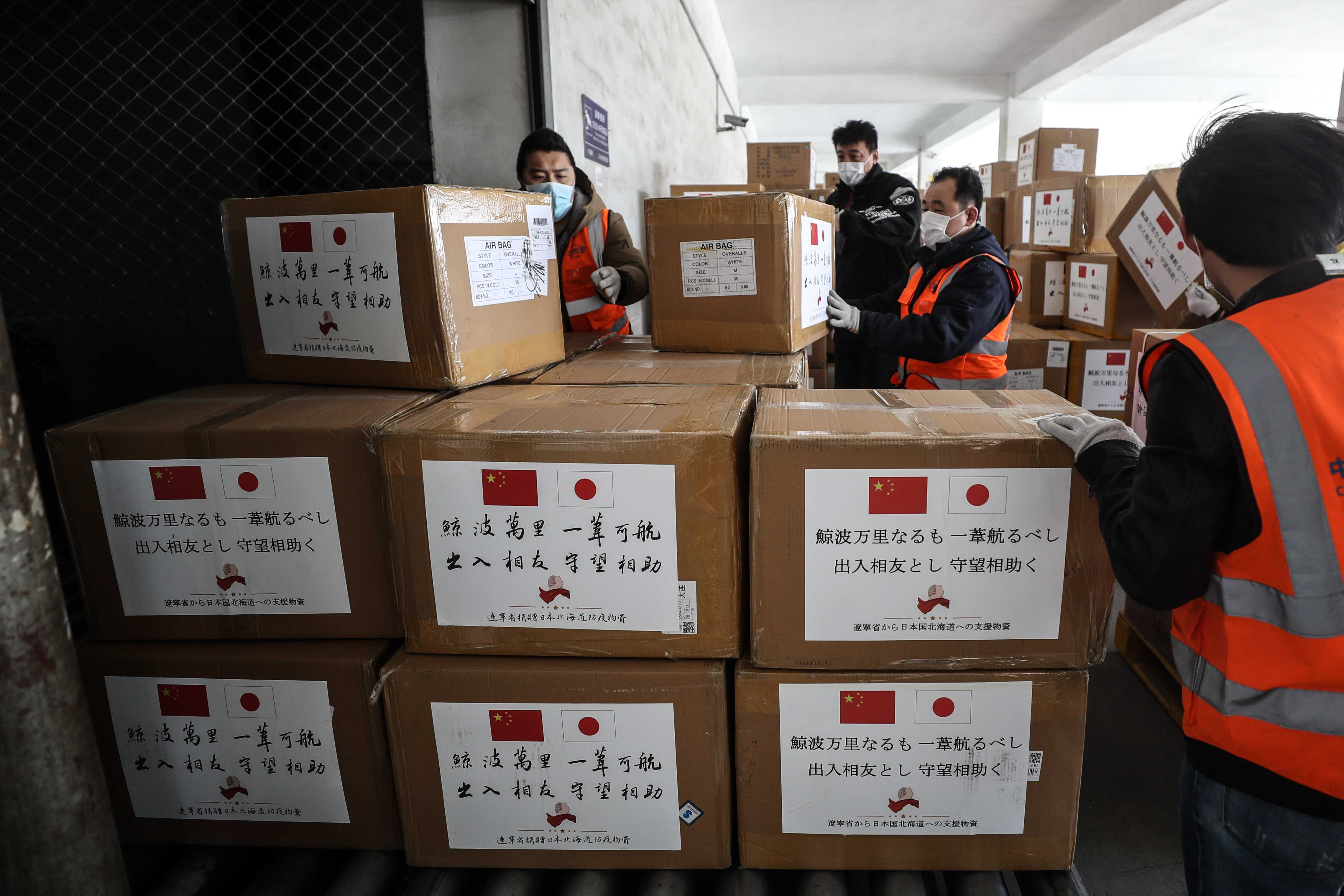no new infections of the novel coronavirus were reported on wednesday in wuhan, the epicenter of the epidemic, marking a notable first in the city's months-long battle with the virus and sending a message of hope to a world grappling with the pandemic.
the health commission of hubei province, where wuhan is the capital, said the virus' death toll climbed by eight in the province, but the total confirmed cases of the novel coronavirus disease (covid-19) in wuhan and hubei remained at 50,005 and 67,800 on wednesday.
no increase was observed in the province's number of suspected cases, which fell to zero on tuesday, in another indication that large-scale transmissions have been suppressed at the epidemic epicenter after a slew of strict measures.

medical workers from yunnan province wave to bid farewell on the plane at tianhe international airport in wuhan, central china's hubei province, march 18, 2020. (xinhua/fei maohua)
previously, the central chinese province had reported single-digit increases of new infections, all of which were from wuhan, for a week in a row since last wednesday. a month ago, the figure was several thousand a day.
the province also saw 795 patients discharged from hospital after recovery on wednesday, reducing its caseload of hospitalized patients to 6,636, including 1,809 in severe condition and 465 in critical condition.
with no new cases in wuhan, the chinese mainland on wednesday reduced the increase in domestic transmissions to zero, according to the national health commission. the mainland now faces a greater threat of infections imported from overseas, which jumped by 34 on wednesday.
"the clearing of new infections in wuhan came earlier than predicted, but it is still too early to let down our guard," said zhang boli, one of the leading experts advising on the epidemic fight in hubei.
arduous work still lies ahead as china strengthens its defence against imported cases from abroad, treats thousands of patients still in serious or critical condition and rehabilitates those discharged from hospitals, said zhang, an academician of the chinese academy of engineering.
with the strict measures in place, a drastic rebound in new infections is unlikely, said chen erzhen, who leads a shanghai medical team assisting hubei.
however, chen noted an alarming fact that there are still patients recently diagnosed at fever clinics, calling for continued epidemiologic investigation.
"today is a big day for wuhan, but we can't afford a minute of relaxation," he said. "we are still fighting toward a final victory in wuhan to be marked by more days of zero increase."
in a leadership meeting on wednesday, xi jinping, general secretary of the communist party of china (cpc) central committee, said the positive trend in preventing and controlling the epidemic has been constantly consolidated and expanded.
he stressed efforts to protect the hard-won positive trend as new situations and problems, especially the overseas spread of the virus and its negative impacts on the world economy, brought new challenges.
the novel coronavirus was first identified in wuhan in december as a new pathogen facing mankind. before its traits were fully understood, the virus had cut a swath of infections among wuhan's unsuspecting public, before jumping from the transportation hub to other parts of china via the largest seasonal human migration ahead of the spring festival.
xi has described the covid-19 outbreak as the most difficult to contain since the founding of the people's republic of china in 1949 and "a big test" for the country.
medical experts said the virus is more contagious, though less deadly, than the sars virus that belongs to the same coronavirus family. globally, the sars virus infected 8,422 people and killed 919 between 2002 and 2003.
"we still have insufficient knowledge of the novel coronavirus. what we already know is it's a very cunning virus with a long incubation period," said wang daowen, a cardiologist at tongji hospital in wuhan.
"we still found the virus from the anus, if not from the lungs, of one patient after he was hospitalized for 50 days," said wang, who was among the first medical experts joining the treatment of covid-19. "usually, a virus should vanish from one's body in two weeks."
turning tide
the chinese mainland began to see a drop in the number of covid-19 patients on feb. 18, after the number of recovered patients surged and new cases declined. by late february, the virus had withdrawn from most regions on the chinese mainland, with only single-digit daily increases of infections in areas outside wuhan.
on march 6, the epidemic epicenter wuhan slashed the daily increase of confirmed cases to below 100, down from a peak of more than 14,000 in early february. bruce aylward, who led the china-who joint mission on covid-19, said the outbreak in china had come down "faster than would have been expected."
on march 11, the daily increase of locally transmitted infections dropped to single digits for the first time on the chinese mainland, where the virus has so far caused a total of 80,928 infections and 3,245 fatalities, defying earlier predictions by foreign researchers of a more extensive national outbreak.

a staff member passes nucleic acid test kits at the plant of luoyang ascend biotechnology co., ltd in luoyang, central china's henan province, march 4, 2020. (xinhua/li jianan)
behind the downward trends were a raft of strong measures taken by the chinese government, including canceling mass events, closing scenic attractions, suspending long-distance buses and asking hundreds of millions of chinese to stay indoors to break transmission chain.
on jan. 23, wuhan declared unprecedented traffic restrictions, including suspending the city's public transport and all outbound flights and trains, in an attempt to contain the epidemic within its territory.
the situation in wuhan and its nearby cities was grim. officials said more than 3,000 medics in hubei contracted the virus at the early stage of the outbreak due to limited knowledge of the virus. many families lost multiple loved ones.
following reports of overloaded local hospitals, more than 42,000 medical staff, including those from the military, were dispatched to hubei from across the country. at the peak of the fight, one in 10 intensive care medics in china were working in wuhan.
fleets of trucks carrying aid goods and displaying banners of "wuhan be strong!" rushed to the city from all corners of the country. under a "pairing-up support" system, each city in hubei is taken care of by at least one provincial-level region.
to ensure the timely admission of patients, two hospitals with a total of 2,600 beds were built from scratch in wuhan within about two weeks, and 16 temporary hospitals were converted from gyms and exhibition centers to add 13,000 beds. nucleic acid testing (nat) capacity in wuhan reached 24,000 people a day. testing is made free and treatment fees are covered by china's basic medical insurance.
huang juan, 38, witnessed the first few days of chaos and despair at local hospitals before calm and order gradually set in amid the influx of support.
huang recalled the hospitals were packed with patients -- over 100 patients were waiting for the injection but only one nurse was around. every day, her mother who had a fever on the eve of the spring festival in late january, waited 10 hours to be injected.
after a week of imploration, huang finally found a hospital willing to admit her mother. ten days later, her mother was discharged upon negative nat results. "she still had symptoms, but there was no choice, as many patients were waiting for beds," huang said.
the situation improved when her father, also diagnosed with the disease, was hospitalized on feb. 19.
"he was discharged after the doctor confirmed his recovery on march 11. it was apparent that the standards for discharge were raised as wuhan got sufficient beds," huang said.
cui cui (pseudonym), 57, also testified to the improving situation. the wuhan resident was transferred to the newly built huoshenshan (fire god mountain) hospital as her sickness worsened on feb. 10.
the military-run hospital that treats severe cases impressed her with a calm ambiance. "doctors and nurses there called me 'auntie' instead of 'patient' and spent time chatting with me to ease my anxiety," said cui, who was discharged after recovering on feb. 26.
community control
outside hubei, the battle against the epidemic has tested the mobilization capacity of china's big cities and remote villages alike as they scrambled to prevent sporadic imported cases from evolving into community outbreaks.
earlier this month, beijing said about 827,000 people who returned to the capital city after the spring festival holiday were placed in two-week home observation. around 161,000 property management staff and security guards were on duty to enforce the quarantine rules.

an inbound passenger prepares to board a transfer vehicle at the transit center converted from the new china international exhibition center in beijing, capital of china, march 17, 2020. (xinhua/peng ziyang)
shanghai, a metropolis in eastern china, has demanded its over 13,000 residential communities to guard their gates and take temperatures of residents upon entrance, according to zeng qun, deputy head of the shanghai civil affairs bureau.
quyi community was among the first shanghai neighborhoods to adopt closed-off management. since late january, it has been disinfecting public areas, introducing contactless deliveries and ensuring residents returning from severely affected regions are placed in quarantine.
"for those who are under self-quarantine at home, health workers will provide door-to-door visits every day, and services from grocery shopping to psychological counseling are offered," said huang ying, an official with hongkou district where the community is located.
shanghai, with a population of 24 million, is among china's most populous cities and a commercial hub. it was once predicted as the most susceptible to a coronavirus outbreak.
mathematical models estimated that without prevention and control measures, shanghai's infection numbers would exceed 100,000. even with some interventions, the figure could still reach tens of thousands, according to zhang wenhong, who heads shanghai's medical team to fight the epidemic.
"but now, the infection number is just over 300. this means the measures taken by shanghai over the past month are effective," zhang said, describing the city as an epitome of china's battle against the epidemic.
new battlegrounds
china's economy became a new battleground as the war against the virus wore on, delaying the reopening of plants after the spring festival holiday and causing a shortage of workers with the nationwide traffic restrictions in place.
china has about 170 million rural migrant workers employed away from their hometowns, many of whom could not return to work as enterprises across the country began to resume production on feb. 10.
in response, local governments have arranged chartered flights and trains to take workers directly to the factories while issuing subsidies to tide companies over difficulties. by early march, the southern manufacturing heartland guangdong province had seen 91.2 percent of firms resume operation.
almost every sector of chinese society has chipped in on the anti-virus fight, from barbers offering medics free haircuts to factories revamping their assembly lines to produce medical masks.
according to the ministry of industry and information technology, china's output of protective clothing has surged to 500,000 pieces per day from fewer than 20,000 pieces at the beginning of the outbreak. the daily output of n95-rated medical masks rose from 200,000 to 1.6 million, while that of regular masks reached 100 million.
"china's economic and social development over the past decade has laid a sound foundation for the fight against the epidemic and enabled the society to mobilize more quickly," said tang bei, an international public health researcher at shanghai international studies university.

a staff member introduces an ai digital infrared thermometer at a building in beijing, capital of china, march 16, 2020. (xinhua/ren chao)
china's tech boom also made contributions -- tech companies rolled out disinfecting robots, thermal camera-equipped drones and ai-powered temperature measurement equipment, which have been rapidly deployed to reduce the risks of cross-infection.
the outbreak has led to what is being called "the world's largest work-from-home experiment." the number of online meetings supported by tencent meeting on feb. 10, when most enterprises started resuming work, was 100 times that of its previous average daily use.
lu chuanying, a researcher with shanghai institutes for international studies, said digital technologies have risen to the fore, not only in the country's anti-virus efforts but also in the recovery of the virus-hit economy.
"remote consultations, artificial intelligence and big data were used to contain the epidemic, while telecommuting, online education and online vegetable markets have kept our lives in quarantine going," lu said.
experience and soul-searching
bruce aylward in an interview with the new york times commended china's counterattack against the epidemic, saying it can be replicated but requires speed, money, imagination and political courage.
aylward praised china's mobilization capability. "they're mobilized, like in a war, and it's fear of the virus that was driving them. they really saw themselves as on the frontlines of protecting the rest of china and the world," aylward was quoted as saying.
as the covid-19 evolved into a pandemic, the chinese government has promised to share its experience and offer medical supplies including masks and test kits to other hard-hit countries.

staff members prepare medical supplies to be delivered to japan and south korea at a customs warehouse in shenyang, capital of northeast china's liaoning province, march 15, 2020. (xinhua/pan yulong)
the country's focus on cutting transmission routes and giving timely treatment to confirmed cases has proved a universal golden rule in epidemic containment, said tang bei.
tang also noted china's close cooperation and information sharing with the who and neighboring countries early on. china shared the full genome sequences of the new virus with the who and the international community soon after identifying the pathogen on jan. 7.
"international cooperation is a key feature of china's battle with the coronavirus, and it should be an element of all other countries' epidemic responses," she said.
the expert said the outbreak also exposed problems in china's health sector, including weakness in grassroots health systems, poor emergency responses of some local governments and the absence of private hospitals in a public health crisis.
as for legacies in the long run, lu said the epidemic has greatly raised public health awareness and promoted medical knowledge in china. there have been growing calls among the chinese public for enhanced wildlife protection, which will help wean the traditions of eating bushmeat in some areas, he said.
for now, the news may come as a balm for many people in wuhan, who have made huge sacrifice in the months-long quarantine.
"what i want now is to hug my parents and have a good cry," said huang. "in the past, i cared more about making money, but now i understand how important it is to be healthy and with my family."
